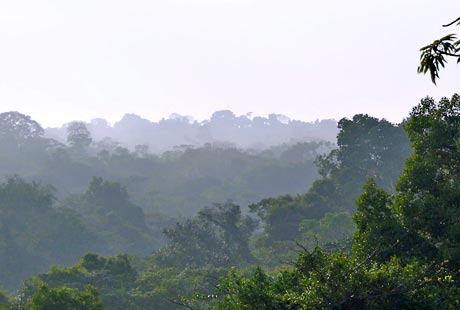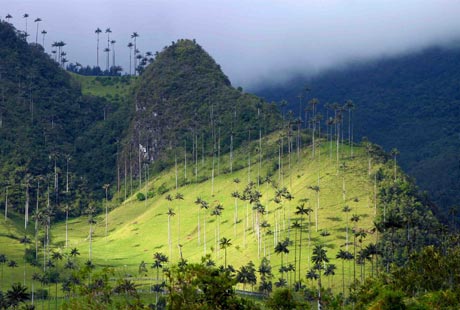Colombia
Country statistics

Land area: 401,042 sq miles (1,038,699 sq km)
Total area: 439,736 sq miles (1,138,910 sq km)
Population (2010 est.): 44,205,293 (growth rate: 1.1%); birth rate: 17.7/1000; infant mortality rate: 16.8/1000; life expectancy: 74.3; density per sq km: 43
Capital City: Santafé de Bogotá
Monetary unit: Colombian Peso
Languages: Spanish
Ethnicity/race: mestizo 58%, white 20%, mulatto 14%, black 4%, mixed black-Amerindian 3%, Amerindian 1%
Religions: Roman Catholic 90%
Country introduction

Colombia is located in the north-western region of South America, bordered to the east with Venezuela and Brazil, to the south with Ecuador and Peru, to the north with the Atlantic Ocean and Caribbean Sea, and to the west with Panama and the Pacific Ocean.
The geography of Colombia can be characterized by its five main natural regions distinguished to climate and landscape. The central west section of the country is occupied by the Andes mountain range shared with Ecuador and Venezuela, to the west is the Pacific Ocean coastal region shared with Panama and Ecuador, to the north is the Caribbean Sea coastal region shared with Venezuela and Panama, to the east is the plains of the Orinoco shared with Venezuela, and located in the south of the country is the Amazon Rainforest region shared with Venezuela, Brazil, Peru and Ecuador.
The Andes Mountains is the country's most diverse region where a majority of the population lives. About 70% of Colombians live here mainly in the cities of Bogotá, Medellin and Santiago de Cali. The mountains separate into three chains that cross Colombia from south to north and create a rugged terrain, with peaks higher than 5,300 m (17,388 ft) above sea level, expansive highland plains, deep canyons and broad valleys.
The Pacific Coast stretches for 1,300 km (808 miles),and is one of the wettest regions on Earth, with a rainfall of over 10,000 mm3 per year. The northern part, where the hills of Baudó sink into the ocean forming bays and sounds, is a jungle region of great biodiversity. The flatter south is bordered by cliffs and beaches lined with mangrove and crossed by wide rivers.
The Caribbean coast extends for 1,600 km (994 miles) and covers a range of ecosystems, from the dense jungles of Darién Gap on the border with Panama in the west, to the desert of La Guajira near Venezuela in the east. Also there are a few major cities in this region such as Cartagena, Santa Marta and Barranquilla.
The plains of the Orinoco spreads out eastwards and has savannas spotted with scrub and riverain forests. Crossed by broad rivers, the Orinoco plains cover over 230,000 sq km (142,915 sq miles), representing 20% of the country. The Serrania de La Macarena rises in the south-west, a formation independent of the Andes and endowed with an immense biodiversity, in which natural elements of the Andes, the Amazon and the Orinoco merge.
The forest of the Amazon covers 42% of Colombia, but only 3% of Colombians live there. This immense region is considered the lungs of the Earth and has the greatest collection of plant and animal life. It is also inhabited by numerous Indian communities who continue to preserve their ancestral way of life.
The culture

Colombia has extremely varied cultural influences from native American, Spanish and other European, African, American, Caribbean, and Middle Eastern influences, as well as other Latin American countries.
The Spanish arrived with the Conquest and colonization and brought slaves with them from Africa. For this reason Colombia is a multi-ethnic and pluri-cultural nation, where each region has its own characteristics that distinguish it from the others. Many variations can be seen in different regions from the accents, dress, music, food, politics and general attitude. There are big differences between the Bogotanos and other residents of the central highlands, the paisas of Antioquia and the coffee region, the costeños of the Caribbean coast, the llaneros of the eastern plains, and the inhabitants of the Pacific coast and the vast Amazon region to the south-east.
An inheritance from the colonial era, Colombia remains a deeply Roman Catholic country and maintains a large base of Catholic traditions which provide a point of unity for its multicultural society. Colombia has many celebrations and festivals throughout the year, and the majority are rooted in these Catholic religious traditions. However, many are also infused with a diverse range of other influences. Prominent examples of Colombia's festivals include the Barranquilla Carnival, the Carnival of Blacks and Whites, Medellín's Festival of the Flowers and Bogotá's Ibero-American Theater Festival.
The mixing of various different ethnic traditions is reflected in Colombia's music and dance. The most well-known Colombian genres are Cumbia and Vallenato, the latter now strongly influenced by global pop culture. A powerful and unifying cultural medium in Colombia is television. Most famously, the telenovela Betty La Fea (Ugly Betty) has gained international success through localized versions in the United States, Mexico, and elsewhere.
Attractions & landmarks

Tourists to Colombia can choose to visit several of the country's numerous destinations on its varied terrain that encompasses mountains, rainforests and two oceans. Its diverse population creates a rich culture with unique traditions and celebrations.
By far the biggest tourist attraction is the the Amazon Jungle, located in Southern Colombia. It is home to the largest and most bio-diverse rainforest in the world. It covers approximately 42% of the land area of Colombia and has the highest variety of animals and plants in the world. The region includes Isla de los Micos, or Monkey Island, home to a forest full of wildlife including apes. The Amacayacu National Natural Park has more than 600 species of animals and includes flooded swamps, marshes and rivers that are navigable by boat. The region is also home to multiple indigenous communities including the Tanimboca reservation and the small Tikuna Indian community.
Colombia's capital of Bogotá is in the central part of the country. The city is situated in the Andes mountain chain and is surrounded by five rivers, including the Bogotá River. Bogotá is considered the educational and cultural center of Colombia and has more than 60 museums and art galleries, the most famous Rock Festival of the continent and the most important theater festival in the world (the Iberoamerican Theater Festival), 29 religious temples that are part of its heritage, 4,500 parks, numerous national monuments and close to 50 shopping malls and outlets where visitors can purchase the latest fashion wear. Bogotá is also home to Ciclovia, the world's largest bicycling network, which covers close to 300 km (186 miles).
Another place to visit is the The Caldas, Quindío and Risaralda regions of Colombia, which are collectively known as the Eje Cafetero, or Coffee Triangle. The region is the largest producer of the country's famous coffee and home to numerous coffee plantations and farms. Many of the popular region's coffee mansions and farmhouses have been transformed into tourist accommodations. Additionally, plantation tours give visitors the chance to see how Colombian coffee is grown and processed. In addition to the coffee crops, the region's diverse landscape includes hot springs, waterfalls and hills covered with wax palm trees.
Barranquilla, also known as Curramba la Bella, or Curramba the Beautiful, is on Colombia's east coast. The city is Colombia's main seaport and home to the Banco de la Republica, a famous exhibit hall that features fine paintings and sculptures. The city also hosts one of the world's largest Carnival celebrations, the Carnaval de Barranquilla, which features traditional dance, music, costumes and crafts. This annual four-day celebration begins before Ash Wednesday and features the Batalla de las Flores, or Battle of the Flowers, and the Grand Parade.